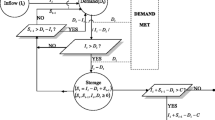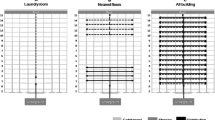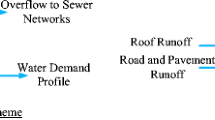Abstract
Rainwater harvesting (RWH) systems are effective in alleviating water supply shortages, while green roofs (GRs) can contribute to stormwater management, air quality improvement, thermal regulation of buildings, and biodiversity support. Despite their individual benefits, both systems are not frequently combined. This paper investigates the potential for integrating these systems through a hydrologic modeling and optimization approach, using a case study in Paris, France. The study utilized a Conceptual Interflow model (CI-model) coupled with a Water Balance (WB) model to describe the rainfall-runoff relationship of integrated green roof and rainwater harvesting (GR-RWH) systems. An NSGA-II optimization was then applied to the CI-WB model to determine the optimal tank sizing of GR-RWH systems for meeting different water demands. The results show that GR-RWH systems have water reliability (WR) values similar to those of traditional RWH systems without GR, albeit with larger tank volumes. For new buildings in Paris, a GR-RWH system with approximately 25 to 75% GR coverage meets rainwater utilization needs with low investment while also providing the added benefits of GRs.


Similar content being viewed by others
Availability of Data and Material
Not applicable.
References
Abdulla F (2020) Rainwater harvesting in Jordan: potential water saving, optimal tank sizing and economic analysis. Urban Water J 17(5):446–456. https://doi.org/10.1080/1573062x.2019.1648530
Alim MA, Rahman A, Tao Z, Samali B, Khan MM, Shirin S (2020) Feasibility analysis of a small-scale rainwater harvesting system for drinking water production at Werrington, New South Wales, Australia. J Clean Prod. 270. https://doi.org/10.1016/j.jclepro.2020.122437
Almeida AP, Liberalesso T, Silva CM, Sousa V (2021) Dynamic modelling of rainwater harvesting with green roofs in university buildings. J Clean Prod 312:1. https://doi.org/10.1016/j.jclepro.2021.127655
An KJ, Lam YF, Hao S, Morakinyo TE, Furumai H (2015) Multi-purpose rainwater harvesting for water resource recovery and the cooling effect. Water Res 86:116–121. https://doi.org/10.1016/j.watres.2015.07.040
Bayesteh M, Azari A (2021) Stochastic optimization of reservoir operation by applying hedging rules. J Water Resour Plan Manag 147(2):04020099. https://doi.org/10.1061/(ASCE)WR.1943-5452.0001312
Berardi U, GhaffarianHoseini A, GhaffarianHoseini A (2014) State-of-the-art analysis of the environmental benefits of green roofs. Appl Energy 115:411–428. https://doi.org/10.1016/j.apenergy.2013.10.047
Campisano A, Butler D, Ward S, Burns MJ, Friedler E, DeBusk K, ... Han M (2017) Urban rainwater harvesting systems: Research, implementation and future perspectives. Water Res 115:195–209. https://doi.org/10.1016/j.watres.2017.02.056
Carbone M, Garofalo G, Nigro G, Piro P (2014) A conceptual model for predicting hydraulic behaviour of a green roof. Procedia Eng 70:266–274. https://doi.org/10.1016/j.proeng.2014.02.030
Cascone S, Coma J, Gagliano A, Perez G (2019) The evapotranspiration process in green roofs: A review. Build Environ 147:337–355. https://doi.org/10.1016/j.buildenv.2018.10.024
Chao-Hsien L, En-Hao H, Yie-Ru C (2015) Designing a rainwater harvesting system for urban green roof irrigation. Water Sci Technol-Water Supply 15(2):271–277. https://doi.org/10.2166/ws.2014.107
Cirkel DG, Voortman BR, van Veen T, Bartholomeus RP (2018) Evaporation from (blue-)green roofs: Assessing the benefits of a storage and capillary irrigation system based on measurements and modeling. Water 10(9). https://doi.org/10.3390/w10091253
Cook LM, Larsen TA (2021) Towards a performance-based approach for multifunctional green roofs: An interdisciplinary review. Build Environ 188. https://doi.org/10.1016/j.buildenv.2020.107489
Dallman S, Chaudhry AM, Muleta MK, Lee J (2017) Erratum to: The value of rain: Benefit-cost analysis of rainwater harvesting systems. Water Resour Manag 31(13):4373–4374. https://doi.org/10.1007/s11269-017-1798-z
Deb K, Pratap A, Agarwal S, Meyarivan T (2002) A fast and elitist multiobjective genetic algorithm: NSGA-II. IEEE Trans Evol Comput 6(2):182–197. https://doi.org/10.1109/4235.996017
Dixon A, Butler D, Fewkes A (1999) Water saving potential of domestic water reuse systems using greywater and rainwater in combination. Water Sci Technol 39(5):25–32. https://doi.org/10.1016/S0273-1223(99)00083-9
Fewkes A (2000) Modelling the performance of rainwater collection systems: towards a generalised approach. Urban Water 1(4):323–333. https://doi.org/10.1016/S1462-0758(00)00026-1
Francis LFM, Jensen MB (2017) Benefits of green roofs: A systematic review of the evidence for three ecosystem services. Urban For Urban Green 28:167–176. https://doi.org/10.1016/j.ufug.2017.10.015
Goorani Z, Shabanlou S (2021) Multi-objective optimization of quantitative-qualitative operation of water resources systems with approach of supplying environmental demands of Shadegan Wetland. J Environ Manag 292:112769. https://doi.org/10.1016/j.jenvman.2021.112769
Hajani E, Rahman A (2014) Reliability and cost analysis of a rainwater harvesting system in peri-urban regions of greater Sydney. Australia Water 6(4):945–960. https://doi.org/10.3390/w6040945
Hardin M, Wanielista M, Chopra M (2012) A mass balance model for designing green roof systems that incorporate a cistern for re-use. Water 4(4). https://doi.org/10.3390/w4040914
Hendriks MMWB, de Boer JH, Smilde AK, Doornbos DA (1992) Multicriteria decision making. Chemom Intell Lab Syst 16(3):175–191. https://doi.org/10.1016/0169-7439(92)80036-4
Imteaz MA, Adeboye OB, Rayburg S, Shanableh A (2012) Rainwater harvesting potential for southwest Nigeria using daily water balance model. Resour Conserv Recycl 62:51–55. https://doi.org/10.1016/j.resconrec.2012.02.007
Jahanfar A, Drake J, Sleep B, Gharabaghi B (2018) A modified FAO evapotranspiration model for refined water budget analysis for Green Roof systems. Ecol Eng 119:45–53. https://doi.org/10.1016/j.ecoleng.2018.04.021
Karim MR, Bashar MZI, Imteaz MA (2015) Reliability and economic analysis of urban rainwater harvesting in a megacity in Bangladesh. Resour Conserv Recycl 104:61–67. https://doi.org/10.1016/j.resconrec.2015.09.010
Kolokotsa D, Santamouris M, Zerefos SC (2013) Green and cool roofs’ urban heat island mitigation potential in European climates for office buildings under free floating conditions. Sol Energy 95:118–130. https://doi.org/10.1016/j.solener.2013.06.001
l'eau CDIS (2015) Le prix du service de l’eau - Cieau | Centre d'information sur l'eau. https://www.cieau.com/le-metier-de-leau/prix-des-services-deau/. Accessed Apr 2022
Leal Filho W, Echevarria L, Omeche V, Al-Amin A (2017) An evidence-based review of impacts, strategies and tools to mitigate urban heat islands. Int J Environ Res Public Health 14:1600. https://doi.org/10.3390/ijerph14121600
Lepp NW (2008) Planting green roofs and living walls. J Environ Qual 37(6):2408–2408. https://doi.org/10.2134/jeq2008.0016br
Li Y, Babcock RW Jr (2014) Green roof hydrologic performance and modeling: a review. Water Sci Technol 69(4):727–738. https://doi.org/10.2166/wst.2013.770
Lynch DF, Dietsch DK (2010) Water efficiency measures at Emory University. J Green Build 5(2):41–54. https://doi.org/10.3992/jgb.5.2.41
Manso M, Teotonio I, Silva CM, Cruz CO (2021) Green roof and green wall benefits and costs: A review of the quantitative evidence. Renew Sustain Energy Rev 135. https://doi.org/10.1016/j.rser.2020.110111
Maykot JK, Ghisi E (2020) Assessment of a rainwater harvesting system in a multi-storey residential building in Brazil. Water 12(2). https://doi.org/10.3390/w12020546
Melville-Shreeve P, Ward S, Butler D (2016) Rainwater harvesting typologies for uk houses: A multi criteria analysis of system configurations. Water 8(4). https://doi.org/10.3390/w8040129
Mitchell VG, Cleugh HA, Grimmond CSB, Xu J (2008) Linking urban water balance and energy balance models to analyse urban design options. Hydrol Process 22(16):2891–2900. https://doi.org/10.1002/hyp.6868
Monteiro CM, Calheiros CSC, Pimentel-Rodrigues C, Silva-Afonso A, Castro PML (2016) Contributions to the design of rainwater harvesting systems in buildings with green roofs in a Mediterranean climate. Water Sci Technol 73(8):1842–1847. https://doi.org/10.2166/wst.2016.034
Nash JE, Sutcliffe IV (1970) River flow forecasting through conceptual models. J Hydrol
Oberascher M, Zischg J, Palermo SA, Kinzel C, Rauch W, Sitzenfrei R (2019) Smart rain barrels: Advanced LID management through measurement and control. Paper presented at the New Trends in Urban Drainage Modelling, Cham
Oberndorfer E, Lundholm J, Bass B, Coffman RR, Doshi H, Dunnett N, ... Rowe B (2007) Green roofs as urban ecosystems: Ecological structures, functions, and services. Bioscience 57(10):823–833. https://doi.org/10.1641/b571005
Okoye CO, Solyali O, Akintug B (2015) Optimal sizing of storage tanks in domestic rainwater harvesting systems: A linear programming approach. Resour Conserv Recycl 104:131–140. https://doi.org/10.1016/j.resconrec.2015.08.015
Palermo SA, Talarico VC, Pirouz B (2019) Optimizing rainwater harvesting systems for non-potable water uses and surface runoff mitigation. Paper presented at the International Conference on Numerical Computations: Theory and Algorithms
Quaranta E, Dorati C, Pistocchi A (2021) Water, energy and climate benefits of urban greening throughout Europe under different climatic scenarios. Sci Rep 11(1):12163. https://doi.org/10.1038/s41598-021-88141-7
Razzaghmanesh M, Beecham S, Kazemi F (2014) Impact of green roofs on stormwater quality in a South Australian urban environment. Sci Total Environ 470:651–659. https://doi.org/10.1016/j.scitotenv.2013.10.047
Sadeghi KM, Kharaghani S, Tam W, Gaerlan N, Loáiciga H (2019) Green stormwater infrastructure (GSI) for stormwater management in the City of Los Angeles: Avalon green alleys network. Environ Process 6(1):265–281. https://doi.org/10.1007/s40710-019-00364-z
Sampson DA, Cook EM, Davidson MJ, Grimm NB, Iwaniec DM (2020) Simulating alternative sustainable water futures. Sustain Sci 15(4):1199–1210. https://doi.org/10.1007/s11625-020-00820-y
Santos C, Taveira-Pinto F (2013) Analysis of different criteria to size rainwater storage tanks using detailed methods. Resour Conserv Recycl 71:1–6. https://doi.org/10.1016/j.resconrec.2012.11.004
Santos SM, Ferreira Silva JF, Santos GC, Macedo PMT, Gavazza S (2019) Integrating conventional and green roofs for mitigating thermal discomfort and water scarcity in urban areas. J Clean Prod 219:639–648. https://doi.org/10.1016/j.jclepro.2019.01.068
Scolaro TP, Ghisi E (2022) Life cycle assessment of green roofs: A literature review of layers materials and purposes. Sci Total Environ 829. https://doi.org/10.1016/j.scitotenv.2022.154650
Singh A, Sarma AK, Hack J (2020) Cost-effective optimization of nature-based solutions for reducing urban floods considering limited space availability. Environ Process 7(1):297–319. https://doi.org/10.1007/s40710-019-00420-8
Słyś D (2009) Potential of rainwater utilization in residential housing in Poland. Water Environ J 23(4):318–325. https://doi.org/10.1111/j.1747-6593.2008.00159.x
Słyś D, Stec A (2020) Centralized or decentralized rainwater harvesting systems: A case study. Resources 9(1). https://doi.org/10.3390/resources9010005
Souto SL, Reis RPA, Campos MAS (2023) Impact of installing rainwater harvesting system on urban water management. Water Resour Manag 37(2):583–600. https://doi.org/10.1007/s11269-022-03374-z
Stec A, Zeleňáková M (2019) An analysis of the effectiveness of two rainwater harvesting systems located in central eastern Europe. Water 11(3). https://doi.org/10.3390/w11030458
Susca T, Gaffin SR, Dell’Osso GR (2011) Positive effects of vegetation: Urban heat island and green roofs. Environ Pollut 159(8–9):2119–2126. https://doi.org/10.1016/j.envpol.2011.03.007
Tamane S, Dey N, Hassanien AE (2021) Security and privacy applications for smart city development. Springer International Publishing Cham
UN (2015) The Global Goals. from http://www.globalgoals.org/
Van Mechelen C, Dutoit T, Hermy M (2015) Adapting green roof irrigation practices for a sustainable future: A review. Sustain Cities Soc 19:74–90. https://doi.org/10.1016/j.scs.2015.07.007
Versini P-A, Stanic F, Gires A, Schertzer D, Tchiguirinskaia I (2020) Measurements of the water balance components of a large green roof in the greater Paris area. Earth System Science Data 12(2):1025–1035. https://doi.org/10.5194/essd-12-1025-2020
Vialle C (2011) Etude du comportement hydraulique, physico-chimique et microbiologique d'un syst¨¨me de r¨¦cup¨¦ration d'eaux de toiture. Evaluation de l'empreinte environnementale. (PhD Thesis). Retrieved from https://oatao.univ-toulouse.fr/6935/
Vieira N, Queiroz T, Fagundes M, Dallacort R (2013) Potential of utilization of rain water excess for irrigation of green roofs in Mato Grosso, Brasil. Eng Agric 33:857–864. https://doi.org/10.1590/S0100-69162013000400024
Vijayaraghavan K (2016) Green roofs: A critical review on the role of components, benefits, limitations and trends. Renew Sustain Energy Rev 57:740–752. https://doi.org/10.1016/j.rser.2015.12.119
Xie H, Liu J (2020) A modeling study of the interflow in the green roof. Urban For Urban Green 54. https://doi.org/10.1016/j.ufug.2020.126760
Yang S, Ruangpan L, Torres AS, Vojinovic Z (2023) Multi-objective optimisation framework for assessment of trade-offs between benefits and co-benefits of nature-based solutions. Water Resour Manag 37(6):2325–2345. https://doi.org/10.1007/s11269-023-03470-8
Zaremba GJ, Traver RG, Wadzuk BM (2016) Impact of drainage on green roof evapotranspiration. J Irrig Drain Eng 142(7):04016022. https://doi.org/10.1061/(asce)ir.1943-4774.0001022
Author information
Authors and Affiliations
Contributions
Haowen Xie: Data curation, Software, Writing- Original draft preparation. Mark Randal: Writing- Reviewing and Editing. Sylvana Melo dos Santos: Reviewing and Editing.
Corresponding author
Ethics declarations
Ethics Approval
Not applicable.
Consent to Participate
Not applicable.
Consent to Publish
Not applicable.
Competing Interests
We declare that we have no financial and personal relationships with other people or organizations that can inappropriately influence our work, there is no professional or other personal interest of any nature or kind in any product, service and/or company that could be construed as influencing the position presented in, or the review of, the manuscript entitled.
Additional information
Publisher's Note
Springer Nature remains neutral with regard to jurisdictional claims in published maps and institutional affiliations.
Highlights
• GR-RWH systems require a slightly larger tank volume than RWH to achieve similar water reliability under the same water demand.
• For new building design in Paris, a GR-RWH system with 25 to 75% GR coverage is a promising option due to its cost-effectiveness in meeting rainwater utilization needs while providing additional GR benefits.
• Existing buildings in Paris with a GR could potentially benefit economically from the addition of RWH.
Supplementary Information
Below is the link to the electronic supplementary material.
Rights and permissions
Springer Nature or its licensor (e.g. a society or other partner) holds exclusive rights to this article under a publishing agreement with the author(s) or other rightsholder(s); author self-archiving of the accepted manuscript version of this article is solely governed by the terms of such publishing agreement and applicable law.
About this article
Cite this article
Xie, H., Randall, M. & dos Santos, S.M. Optimization of Roof Coverage and Tank Size for Integrated Green Roof Rainwater Harvesting Systems-a Case Study. Water Resour Manage 37, 4663–4678 (2023). https://doi.org/10.1007/s11269-023-03568-z
Received:
Accepted:
Published:
Issue Date:
DOI: https://doi.org/10.1007/s11269-023-03568-z




